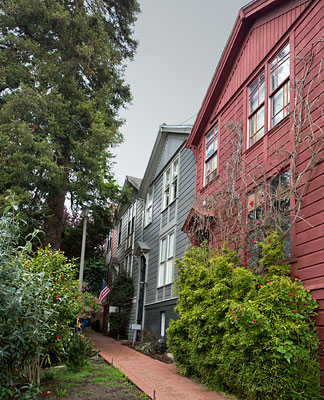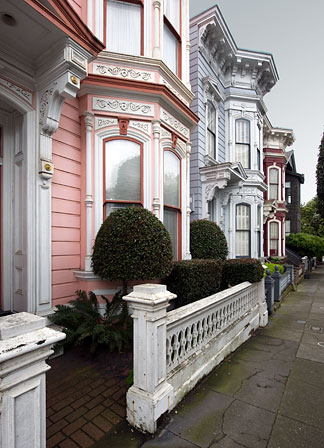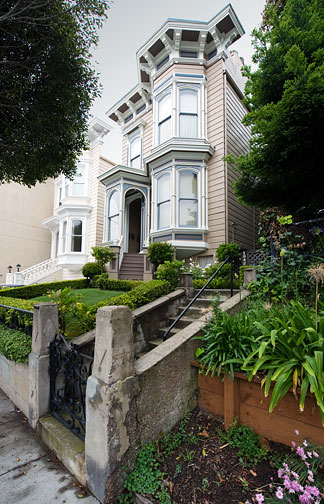National Register of Historic Places in San Francisco
Bush Street-Cottage Row Historic District
2101-2125 Bush Street
1-6 Cottage Row
1940-1948 Sutter Street
Built Various Dates
The Bush Street-Cottage Row District is an intact, century-old enclave within San Francisco's mostly bulldozed Western Addition Redevelopment Area 2. It has "been accorded high praise in both of the City & County surveys: the Junior League Survey published as Here Today, and the Department of City Planning's Architecture Survey of 1976.
[The district] exhibits typical San Francisco housing developments of the mid-l870s and early 1880s, as all the buildings but one rear-yard cottage are the work of just two housing developers, The Real Estate Associates [TREA] and C.L. Taylor.
Source NRHP Nomination Form dated 9 August 1982.

Cottage Row is a miniature and very private-seeming enclave within the District. Here Today describes it as "one of San Francisco's few residential walkways comparable to an English mews."
The lane itself, as well as the partywall houses and 2109-2111 Bush, were all a single piece of private property from Col. Charles L. Taylor's purchase of the land in 1875 until the Bush Street house was separated from the partywall houses in late 1944.
The Cottage Row houses were separated into individual ownership gradually from 1956 to 1967, and only on that last date was the walkway singled out as an individual holding separate from any house.
Taylor himself had chosen the name "Cottage Row," which was listed among San Francisco's streets as early as the 1886 Directory.
In the 1930s the walkway was popularly called Japan Street, because the entire District was inhabited by Japanese-Americans until their internment during World War II. In the tiny rear yards of Cottage Row they grew vegetables, which they offered for public sale at an informal weekly open market held every Saturday along the Row.
Source NRHP Nomination Form dated 9 August 1982.
| Name | Year | Address | Remarks | Sort Address | Sort Name |
|---|---|---|---|---|---|
| Store and Residence | 1874 | 2101-2101A Bush Street | Bush 2101 | Store and Residence | |
| Residence | 1874 | 2103 Bush Street | Italianate with half-octagonal bay. | Bush 2103 | Residence |
| Residence | 1874 | 2105 Bush Street | Italianate with half-octagonal bay. | Bush 2105 | Residence |
| Residence | 1874 | 2107 Bush Street | Italianate with half-octagonal bay. | Bush 2107 | Residence |
| Residence | 1882 | 2109-2111 Bush Street | Stick style with rectangular bay. | Bush 2109 | Residence |
| Residence | 1874 | 2115 Bush Street | Built by TREA. Italianate, flat front and half-octagonal bay in rear. | Bush 2115 | Residence |
| Residence | 1874 | 2117 Bush Street | Built by TREA | Bush 2117 | Residence |
| Garden Cottage | 1874 | 2117-B Bush Street | Built by TREA | Bush 2117B | Garden Cottage |
| Residence | 1874 | 2119 Bush Street | Built by TREA | Bush 2119 | Residence |
| Residence | 1874 | 2121 Bush Street | Built by TREA | Bush 2121 | Residence |
| Residence | 1874 | 2123 Bush Street | Built by TREA | Bush 2123 | Residence |
| Residence | 1874 | 2125 Bush Street | Built by TREA | Bush 2125 | Residence |
| Party-Wall House | 1882 | 1 Cottage Row | All six houses on Cottage Row are essentiallly identicel: simple Stick style with no bay or false front. | Cottage 1 | Party-Wall House |
| Party-Wall House | 1882 | 2 Cottage Row | Cottage 2 | Party-Wall House | |
| Party-Wall House | 1882 | 3 Cottage Row | Cottage 3 | Party-Wall House | |
| Party-Wall House | 1882 | 4 Cottage Row | Cottage 4 | Party-Wall House | |
| Party-Wall House | 1882 | 5 Cottage Row | Cottage 5 | Party-Wall House | |
| Party-Wall House | 1882 | 6 Cottage Row | Cottage 6 | Party-Wall House | |
| Cottage Row Walk | Cottage Row Walk | ||||
| Residence | 1874 | 1942 Sutter Street | Italianate with half-octagonal bay. | Sutter 1942 | Residence |
| Residence | 1874 | 1948 Sutter Street | Italianate with half-octagonal bay. | Sutter 1948 | Residence |


